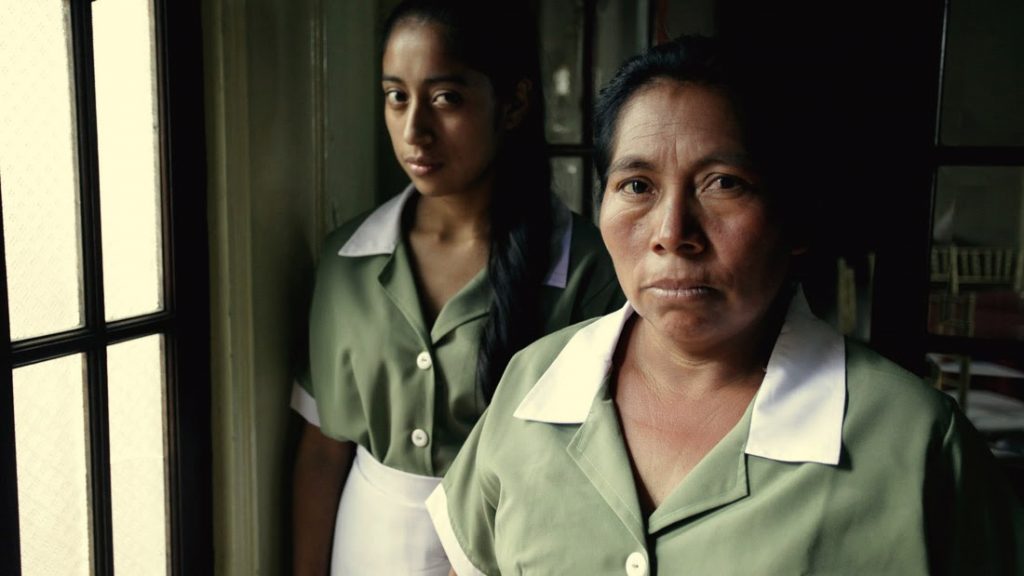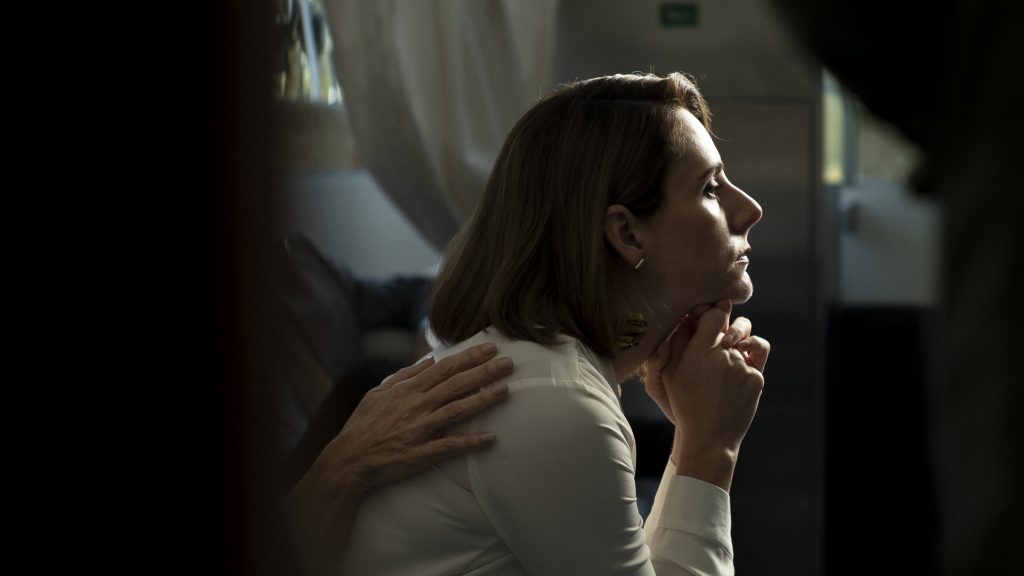August 15, 2020
by Carla Hay

Directed by Jayro Bustamante
Spanish and Kaqchikel with subtitles
Culture Representation: Taking place in Guatemala, the horror film “La Llorona” has an all-Latino cast representing the wealthy and the working-class.
Culture Clash: A convicted war criminal and his family are haunted by the sins from his past.
Culture Audience: “La Llorona” will appeal to people who like horror films that have social commentary beyond the usual scares.

“La Llorona” (written and directed by Jayro Bustamante) goes where few horror movies have gone before, by taking a well-known folk story and giving it a new spin that’s a scathing commentary on human-rights violations committed during war. The movie should not be confused with the vastly inferior 2019 horror flick “The Curse of La Llorona,” a not-very-scary movie that got a lot of criticism for being a “whitewashed” Hollywood version of Hispanic folklore. Instead, “La Llorona” is much better than the average horror flick because it makes a bold statement about the aftermath of war and how the pain doesn’t end after the war is over.
The movie begins with a striking scene of several women gathered in a circle, with lit candles all around, and praying in a chanting manner asking an unknown entity: “Come back to us.” The next scene is of a group of men who are being told, “Remember, you are heroes, not victims.” They are also told that they should wear dark suits, as long as they’re not black suits, and they must never lower their heads.
What do these two groups of people have in common? It’s made clear later in the story, but most of the activity in the movie takes place in a wealthy family’s mansion that is experiencing a lot of emotional turmoil. The family patriarch is Enrique Monteverde (played by Julio Díaz), a former government army general in Guatemala’s civil war in the early 1980s, when General Efraín Ríos Montt’s totalitarian regime fought against insurgent armies (many of whom consisted of indigenous people) that wanted a more democratic rule.
Guatemala eventually made a new constitution allowing free and democratic elections in 1986. But the civil unrest in Guatemala resulted in thousands of people being tortured and killed, with indigenous people as the target of much of the government’s genocide. And decades later, Enrique is on trial for these war crimes that he is accused of committing in 1982 and 1983.
While he is awaiting trial, Enrique and his family have been living a semi-sequestered life in the mansion. His family members in the household are his wife Carmen (played by Margarita Kenétic); their daughter Natalia (played by Sabrina De La Hoz); and Natalia’s daughter Sara (played by Ayla-Elea Hurtado), who’s about 9 or 10 years old. Sara is aware that her grandfather Enrique is a controversial public figure, because she asks her mother Natalia, “Why do people say bad things about my grandpa?” When Natalia asks Sara where she heard these things, Sara tells her that it’s been mostly on the Internet.
One night, Enrique wakes up to the sound of someone taking a shower and breathing heavily in a nearby bathroom. When he goes in the bathroom to investigate, no one is there. The movie has many symbolic and literal references to water and drowning, in a nod to the La Llorona folklore, which is about a ghost woman who’s tormented by the memory of drowning her two young sons.
Is Enrique delusional or was he just dreaming? It’s clear that he has some mental anguish because he’s so freaked out by what he hears in the bathroom that he takes his gun with him. And when his wife Carmen (played by Margarita Kenétic) checks up on him in the bathroom to see what’s going on, he thinks she’s an intruder and he shoots at her and barely misses. The bullet instead hits the bathroom door frame.
The family’s chief maid Valeriana (played by María Telón) has also gone to see what all the ruckus is about. But Enrique, in a state of panic, grabs Valeriana and holds her as if she’s a hostage. During the chaos, Enrique and Carmen’s daughter Natalia runs into the room and sees what’s going on and calls out for the family’s trusted security employee Letona (played by Juan Pablo Olyslager), who manages to get the gun away from Enrique and calm things down.
This disturbing incident was witnessed by several of the live-in servants, who are all indigenous people. The next day, they band together with Valeriana to tell Carmen and Natalia that they want to quit. But Carmen and Natalia convince the servants to stay, by telling them that no other employers will treat them as well as they’ve been treated by the Monteverde family. This scene can be considered symbolic of Spanish colonialism in Guatemala, where indigenous people were kept subservient by Spanish invaders, who believed that they knew what was best for the native people.
It’s also the first real sign of the condescending attitude that Carmen and Natalia have toward people whom they considered “inferior” to them, especially if they are working-class and indigenous people. And it’s also the first indication of how Carmen and Natalia deny and enable Enrique’s bad behavior. Later in the story, it becomes apparent that Carmen is a lot worse than Natalia when it comes to the snobbery toward indigenous people and the covering up of Enrique’s crimes.
And the reason why Carmen has particular disdain for indigenous women is also revealed. (The reason why isn’t so surprising.) Carmen’s willingness to stay silent and cover up for her husband, in order to maintain her outwardly privileged lifestyle, is an attitude that is very common with the spouses of powerful men who are corrupt.
During the trial, people testify about the Guatemalan government army’s vicious torture and killings during the civil war in the early 1980s. One of the witnesses is a woman who testifies to being raped by government soldiers, who then murdered her family. Enrique’s attorney argues that Enrique never ordered the Guatemalan army to kill a specific race or religion. Enrique testifies that any actions he took were to help better establish a national identity.
Enrique is found guilty, and the verdict causes an eruption of chaos in and outside the courtroom. Enrique looks like he’s about to have a heart attack, so he is rushed to a hospital. A huge crowd outside celebrates the verdict. It’s a mob scene of protestors and media that follow the family back to their home. Letona advises that the family stay fully sequestered in their home until the situation dies down.
While Enrique is recuperating in a hospital, Natalia and Carmen have a private conversation at their home. Natalia starts to question Enrique’s mental stability and wonders if they should get him psychiatric help and possibly put him in a psychiatric institution, but Carmen is against the idea. Natalia is also disturbed by the testimony of the prosecution’s witnesses, because she believes them, and she wonders if her father participated in the atrocities that he was accused of ordering.
Carmen’s response is to tell Natalia that many of the women who claimed that they were raped were “whores” who offered themselves to the soldiers, and those who were raped were violated by lower-level soldiers. Carmen says that although Enrique was never a faithful husband, she implies that his military ranking was too high to be a common soldier raping people. Carmen then questions Natalia’s family loyalty by asking, “Which side are you on?” She also asks Natalia if she’s turning into a leftie Communist.
And when Enrique is released from the hospital, it’s another chaotic event with a large crowd of angry protestors surrounding the ambulance that takes Enrique home. It’s revealed later in the story that Enrique’s guilty verdict was overturned. Although he won’t be incarcerated for his crimes, his home has turned into another type of prison.
As the protestors are gathered outside the mansion, they shout angry statements during all hours of the day, but Carmen and Natalia appear to be stoic about all the mayhem. There’s a scene of them sunning themselves outside in their backyard (Natalia is meditating), as if they want to tune out all the uproar surrounding them. But things become dangerous, as the protests start to become violent, with objects being thrown at the house and through windows.
During all of this uproar, a young woman with big, haunting eyes suddenly appears in the crowd. She is let into the house by Valeriana. Her name is Alma (played by María Mercedes Coroy), who has come to work as a live-in maid for the Monteverde family. It isn’t explained why she is in now in the family’s life, but she knows Valeriana very well, so it’s implied that Valeriana is the one who helped get Alma the job.
Alma immediately develops a bond with Sara, who wants Alma to teach her how to hold her breath underwater. It’s soon revealed that Alma has had a tragic life: Her two children (a son and a daughter) have died, and her husband has disappeared. Natalia’s husband (Sara’s father) has also been missing for the last few years, with no signs of foul play. Enrique is convinced that Natalia’s husband abandoned her because her husband doesn’t love her anymore, which is a theory that he cruelly brings up to Natalie when she talks to Enrique about her missing spouse.
After Alma arrives in the household, more strange things starts happening. Carmen begins having nightmares. Enrique does something very creepy, which makes it obvious that he hasn’t changed his ways. And there’s a pet frog that Sara has grown attached to that ends up being the basis for a startling scene in the movie.
“La Llorona” is not the type of horror movie where someone gets attacked or killed every 15 minutes. Instead, the seeping and growing terror is more psychological, although there’s still some disturbing violence in the movie. Alma is the catalyst for many of the things that happen later in the story, but the movie’s emotional center is really Natalia, who becomes increasingly conflicted as she starts to find out that the man she thought her father was directly contradicts with who he actually is.
Writer/director Bustamante has impressively crafted a story not just about revenge for human atrocities but also family betrayal. “La Llorona” has many scenes that are visually striking, beginning with the opening scene, that will send chills up the spines of people watching the movie. And unlike a lot of horror movies, “La Llorona” will make people think about the social issues raised in the film. The movie vividly juxtaposes the brutalities of war with the torment caused by the aftermath of war—and the film makes people wonder which is worse.
Shudder premiered “La Llorona” on August 6, 2020.
